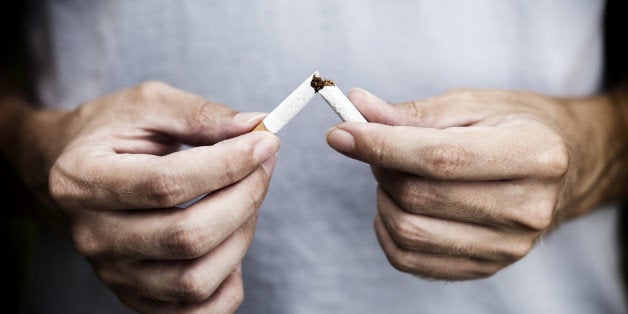
Women who are looking to quit smoking might benefit from checking their ovulation calendars.
A woman’s menstrual cycle could play a role in determining how easy (or difficult) it is for her to quit smoking, according to a small but compelling new pilot study. Lead researcher Adrianna Mendrek of the University of Montreal said that her findings emphasize the need for gender-based smoking cessation therapies that also take menstrual cycle phase into consideration.
To test the theory, researchers recruited 34 chronic but healthy smokers (19 women and 15 men) who weren’t seeking treatment for their addiction. They were each asked to smoke one cigarette 30 to 40 minutes before the experiment to make sure they all had the same baseline for cigarette craving.
Then researchers placed them into an fMRI machine, where they were asked to view alternating sequences of smoking-related photos and neutral photos. After the fMRI session was over, researchers showed participants the photos a second time, and they were asked to rate them on a scale from zero to 100 in terms of how much that picture made them want to smoke a cigarette. Mendrek also tested 13 of the female participants twice, to capture their responses at different points in their menstrual cycle (later confirmed with blood analyses).
The experiments revealed that during a woman’s follicular phase (after one's period but before ovulation), seeing cigarette and smoking imagery greatly activated at least five different centers of the brain, indicating higher cravings. But during a woman’s luteal phase, only one center of the brain responded with limited activation. That makes sense, according to the researchers: elevated levels of the hormones estrogen and progesterone during this phase could be helping women stand strong against withdrawal and craving, while decreased levels during the follicular phase (after one's period) could intensify feelings of withdrawal and craving.
"Our data reveal that [uncontrollable] urges to smoke are stronger at the beginning of the follicular phase that begins after menstruation,” said Mendrek in a statement about her study. "Hormonal decreases of [estrogen] and progesterone possibly deepen the withdrawal syndrome and increase activity of neural circuits associated with craving.”
All the participants were roughly similar when it came to their age, education, number of cigarettes a day (more than 15), years of smoking and their number of quit attempts. They were also similar when it came to their depressive symptoms, anxiety, cravings and craving cues.
It’s important to note that brain imagery was the only way Mendrek was able to demonstrate a meaningful difference in cigarette cravings during follicular versus luteal phases. She was not able to find a significant link between the participants' own reports of their cravings and menstrual phases, for instance. Nor was she able to demonstrate a link between craving ratings and hormone levels in the blood. In the study manuscript, Mendrek also describes the differences in brain activation between the luteal and follicular phase as “subtle” and from a small sample size.
Nevertheless, Mendrek concludes that “taking the menstrual cycle into consideration could help women to stop smoking,” and calls for more studies that investigate the biological differences in men and women when it comes to cigarette smoking and addiction.
Previous brain scans, like those from positron emission tomography (PET scans), offer up a wealth of information about how different genders respond to smoking. A study published in December used PET scans to show that in men, parts of the brain associated with nicotine addiction respond strongly to cigarette smoking. Meanwhile in women, the parts of the brain that lit up during a drag were associated with experiencing the sensory cues of smoking, like the smell and taste of smoke.
Clinical differences between men and women’s smoking addictions and quit attempts are well-documented, too. For instance, men who are trying to quit respond better to the nicotine patch than women who are trying to quit -- perhaps because men's nicotine addictions are being satisfied with the patch, while women’s sensory needs aren’t, as the PET scan experiment suggests. Mendrek also notes in her study that while men smoke at higher rates than women, women take less time to become dependent on cigarettes and also have a more difficult time quitting once they’re hooked.
Smoking kills five million people a year globally, according to the World Health Organization. It’s estimated that women’s smoking rates will rise to match men’s rates in many low- and middle-income countries, and in high-income countries like the U.S., rates of smoking between men and women are almost on par.
